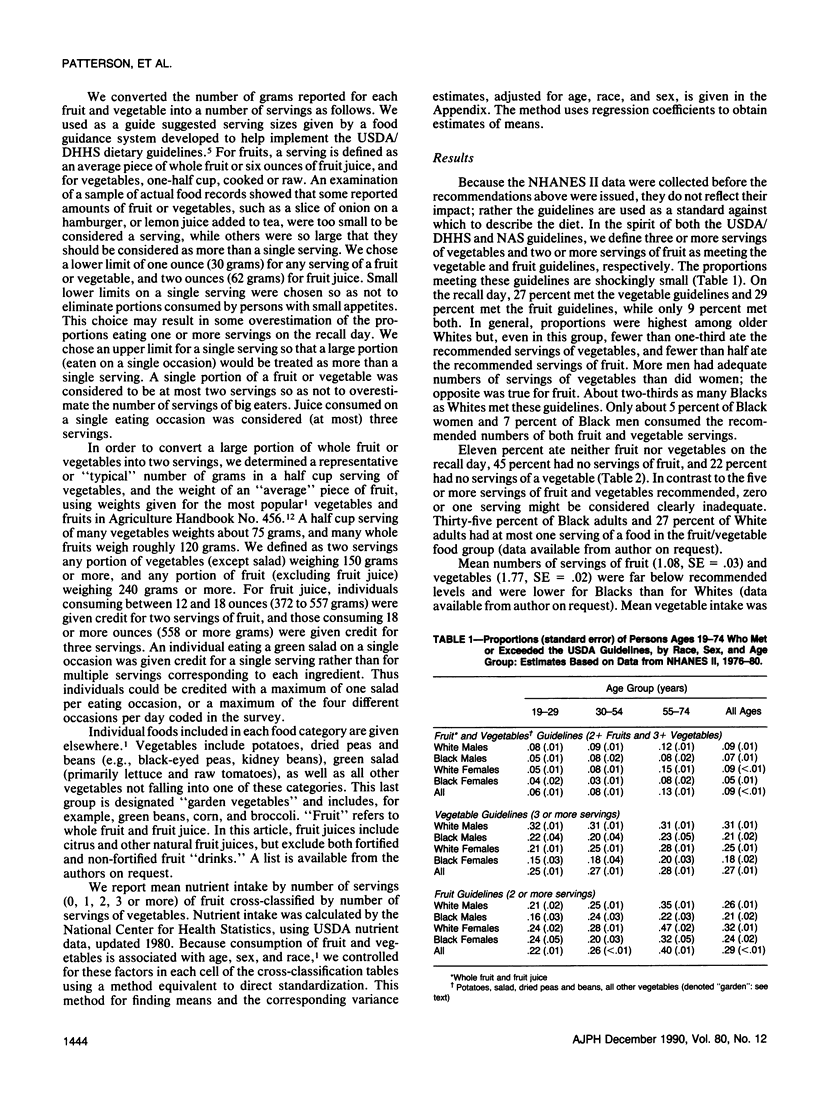Abstract
Twenty-four hour dietary recall data from the Second National Health and Nutrition Examination Survey (1976-80) were used to estimate the numbers of servings of fruit and vegetables consumed by Black and White adults, to examine the types of servings (e.g., potatoes, garden vegetables, fruit, and juice), and to estimate the mean intake of calories, fat, dietary fiber, and vitamins A and C by number of servings. An estimated 45 percent of the population had no servings of fruit or juice and 22 percent had no servings of a vegetable on the recall day. Only 27 percent consumed the three or more servings of vegetables and 29 percent had the two or more servings of fruit recommended by the US Departments of Agriculture and of Health and Human Services; 9 percent had both. Consumption was lower among Blacks than Whites. The choice of vegetables lacked variety. Diets including at least three servings of vegetables and two servings of fruit contained about 17 grams of dietary fiber. Although caloric and fat intake increased with increasing servings of fruit and vegetables, the percent of calories from fat remained relatively constant. Although these data are 10 years old, more recent surveys have shown similar results. The discrepancy between dietary guidelines and the actual diet suggests a need for extensive public education.
Full text
PDF






Selected References
These references are in PubMed. This may not be the complete list of references from this article.
- Block G., Dresser C. M., Hartman A. M., Carroll M. D. Nutrient sources in the American diet: quantitative data from the NHANES II survey. II. Macronutrients and fats. Am J Epidemiol. 1985 Jul;122(1):27–40. doi: 10.1093/oxfordjournals.aje.a114084. [DOI] [PubMed] [Google Scholar]
- Crawford P. The nutrition connection: why doesn't the public know? Am J Public Health. 1988 Sep;78(9):1147–1148. doi: 10.2105/ajph.78.9.1147. [DOI] [PMC free article] [PubMed] [Google Scholar]
- Patterson B. H., Block G. Food choices and the cancer guidelines. Am J Public Health. 1988 Mar;78(3):282–286. doi: 10.2105/ajph.78.3.282. [DOI] [PMC free article] [PubMed] [Google Scholar]
- Peto R., Doll R., Buckley J. D., Sporn M. B. Can dietary beta-carotene materially reduce human cancer rates? Nature. 1981 Mar 19;290(5803):201–208. doi: 10.1038/290201a0. [DOI] [PubMed] [Google Scholar]
- Popkin B. M., Haines P. S., Reidy K. C. Food consumption trends of US women: patterns and determinants between 1977 and 1985. Am J Clin Nutr. 1989 Jun;49(6):1307–1319. doi: 10.1093/ajcn/49.6.1307. [DOI] [PubMed] [Google Scholar]


